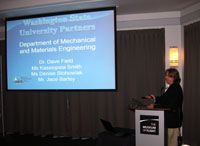Day 2 of the conference is underway. Our first presentation is a highly technical one: “For space elevator rope – Production of exfoliated graphene and high surface charged-cellulose nanocrystals as stabilizer synthesized by lyophilized acidic hydrolysis“. Dr. Sherif Hindi of King Abdulaziz University, in Jeddah, Saudi Arabia, gave this presentation via Skype. It was a difficult presentation to understand; a combination of the subject being highly technical, the presentation given via Skype and that English is not Dr. Hindi’s first language (though his English was excellent). But if I got the gist of it, Dr. Hindi’s work consists of stabilizing/purifying Graphene (and thus making it stronger?) via cellulose nanocrystals produced from renewable materials. I will need to review his paper to learn more.
 The second presentation was by Dr. Bryan Laubscher, chief technologist of Odysseus Technologies, Inc. (full disclosure; I am an investor in OTI). He gave us an update on OTI’s continuing efforts to build longer, stronger nanotubes. He discussed the patents that OTI has made, both in terms of taking existing ‘forests’ of nanotubes, drawing off threads and strengthening those threads and also in growing stronger nanotubes themselves. His presentation elicited many questions and a whole lot of discussion. OTI’s problem now (as with a lot of startups, especially in this field) is funding. OTI is doing a lot with a little – a little more would certainly help. Dr. Laubscher made the observation yesterday that if you want to really advance the possibility of a space elevator, materials science is the place to be. I’ve pointed out the obvious many times on this blog that without the materials strong enough to make a viable space elevator tether, this is all just a pipe-dream. Long, strong tubes are the answer.
The second presentation was by Dr. Bryan Laubscher, chief technologist of Odysseus Technologies, Inc. (full disclosure; I am an investor in OTI). He gave us an update on OTI’s continuing efforts to build longer, stronger nanotubes. He discussed the patents that OTI has made, both in terms of taking existing ‘forests’ of nanotubes, drawing off threads and strengthening those threads and also in growing stronger nanotubes themselves. His presentation elicited many questions and a whole lot of discussion. OTI’s problem now (as with a lot of startups, especially in this field) is funding. OTI is doing a lot with a little – a little more would certainly help. Dr. Laubscher made the observation yesterday that if you want to really advance the possibility of a space elevator, materials science is the place to be. I’ve pointed out the obvious many times on this blog that without the materials strong enough to make a viable space elevator tether, this is all just a pipe-dream. Long, strong tubes are the answer.
